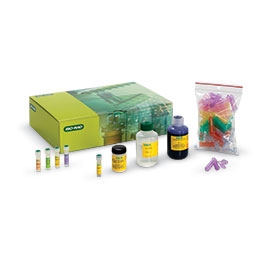
Description
Description
Electrophoretic techniques that distinguish DNA fragments by size are essential in forensics and in the mapping of restriction sites within genes. With the Restriction Digestion and Analysis of Lambda DNA Kit, students use three different restriction enzymes to digest genomic DNA from lambda bacteriophage. By visualizing the effects of three different enzymes on identical samples of double-stranded DNA, students learn that different restriction enzymes recognize and cut different DNA sequences.
Features and Benefits
- Aligns with AP Lab 6
- Teaches about using genetic engineering and restriction enzymes as microbiology tools
With this kit, students are able to:
- Use agarose gel electrophoresis to study digestion patterns
- Generate standard curves from series of DNA size standards
- Analyze migration distances to determine DNA fragment sizes
Students learn the procedures and principles of restriction digestions and DNA gel electrophoresis, including:
- Agarose gel casting
- Sample loading
- Size-based separation of DNA fragments
- DNA staining
- Graphic analysis
How It Works
The lambda genome has approximately 48,000 base pairs. Each restriction enzyme used in this kit cuts the lambda DNA several times, generating distinct sets of DNA restriction fragments of different sizes. The three different sets of DNA fragments that result from the enzymatic digestion are separated by agarose gel electrophoresis and visualized using Bio-Rad's safe Fast Blast™ DNA stain. Banding patterns from each sample are then compared to each other and to a DNA size standard. Students use their electrophoresis results to construct standard curves and determine the precise DNA fragment sizes generated by the different restriction enzymes.
More Information
- Two-session laboratory activity, 45 min per session
- Provides sufficient materials for eight student workstations, up to four students per workstation


